 The excitement and optimism in the Yangon air these days is palpable. In 2011 the impossible happened. The half century of rule by an oppressive military junta was over and longtime political prisoner Aung San Suu Kyi had been released and duly elected to parliament.
The excitement and optimism in the Yangon air these days is palpable. In 2011 the impossible happened. The half century of rule by an oppressive military junta was over and longtime political prisoner Aung San Suu Kyi had been released and duly elected to parliament.
It was shortly after her election that I met with Burmese friends in a crowded coffee shop on Bogyoke Aung San Road, not far from Scott Market. We were there to talk tourism, not politics, but it quickly became apparent the two could not be entirely separated, at least not yet. It was politics that suppressed tourism for so many years, and it’s the lingering hangover of those politics that continue to suppress it today, albeit less and less.
Although Myanmar tourism has been helped markedly by glowing reviews from the likes of Lonely Planet, Conde Nast Traveler and Wanderlust, the numbers behind it’s designation as the world’s “hottest” travel destination in 2012, (a 52% visitor increase from 2011), and very likely again in 2013, (expected to spike another 50%), should be seen in context.
Now that most economic sanctions have been lifted, at least a third of the visitor increase can be attributed to business travel, not tourism. The same for 2013. When you consider this year’s final tally will be right around 1.5 million, and then compare it with neighboring Thailand with projections of 24.5 million, well, there is no comparison.
Let’s face it, as spectacular and welcoming as Myanmar is, it has a perception problem. Despite the heady reforms and positive momentum, there are still serious internal conflicts in dire need of equitable resolutions, most notably with the Karen in Kachin and the Rohingya in Rakhine. That said, the country also has a misperception problem. Millions around the world think it’s a mean and dangerous place to travel, when in reality it’s one of the safest, most relaxing, enriching, and charming travel-spheres anywhere on earth.
There are a number of reasons for the misperception, but I wondered aloud if the all too common confusion over Myanmar/Burma’s dual identity might be at least partially responsible, and if clarifying the nomenclature might do a fair bit in bringing people up to speed. They agreed it might, and set about bringing me up to speed.
The first point of clarity, was that the land has been called Myanmar for at least 1,000 years, not just since 1989. Myanmar has always been the formal, written, and “nation” form of Bamar. The Bamar people are the predominate ethnic group in the nation of Myanmar.
Simple, right? Not so fast, the British are coming!
The British invasion of Myanmar in the 1820’s began 60-years of war, aggression and strategic ethnic division that finally resulted in the 1886 establishment of colonial “Burma”, an obvious derivation of Bamar. The Brits also changed Yangon to Rangoon, and so on.
Burma’s independence came in 1948, but the colonial name was kept until early 1989, when the junta changed Burma back to Myanmar. Since the change came on the heels of the brutal suppression of the 1987 protests for democratic reform, it was widely seen as politically motivated, and generally spurned. In addition, many in the Western media thought the junta had vainly made the name up, having no idea of its 1,000 year pedigree.
-
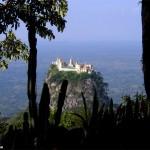
- Mt Popa shrine atop a 1,000 foot spire
-
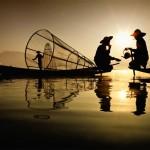
- Luminous Journeys tea Lake Inle-Burma
-
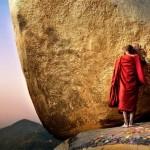
- David Lazar: Golden Rock Myanmar
-
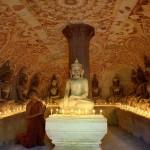
- Bo Bo Zaw Po Winn Daung Buddha caves
-
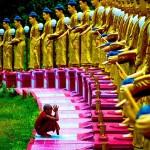
- Aung Pyae Soe Young monk line Buddhas
-

- Walking sun over U Bein Bridge Myanmar Luminous Journeys
Over time most of the world’s nations accepted the return to the original name of Myanmar, and gave it official recognition. To this day however, despite major reforms and Barrack Obama’s repeated use of “Myanmar” during his 2012 visit to Yangon, the United States still refuses to recognize the name change. Great Britain likely never will, lest it draw attention to its historical role in creating what it continues to decry.
Myanmar it is then!
Not quite… Nobel laureate Suu Kyi, the widow of an Englishman and the mother of two Burmese-British sons, uses Burma. Many, mostly older citizens who are still proud of their British “heritage”, will always use Burma. For some it’s as simple as what they grew up with. For others the name Myanmar was forever ruined by the junta. Some of their children would agree. But this understandable grudge view is fading quickly and Myanmar is rising in popularity, both spoken and written, especially among the young.
So what’s a visitor to do? First off, don’t worry about it. You are not going to offend anyone. They are so understanding of the issue that it’s not an issue at all, at least as it relates to visitors. But if you insist, then simply let the person you are talking with tip their hand. If they use Burma, use Burma. If you should speak first and use Myanmar, and they respond using Burma, then follow their lead. It’s a politely subtle way of showing their preference.
Well, now that we’ve cleared that up…
As my friends and I slipped further into the politics of Myanmar tourism, I could sense a quiet caution behind the “excitement and optimism”. It’s a caution that will remain at least until current election rules are changed to enable Aung San Suu Kyi to run for president in 2015. Very recent indications are positive, and if she does end up on the ballot in a fair election, victory is all but a foregone conclusion. This would do more to rescue Myanmar’s political reputation in a single day than all the love lavished by the travel magazines has over the last couple of years. Meanwhile, the best time to beat the growing crowds is as always, now!
Bio: Benn is a writer/photographer and co-founder of LuminousJourneys.net, a joint U.S. / Myanmar venture dedicated solely to authentic travel and learning experiences in Myanmar. “With the country opening up we saw a rare opportunity to combine skills and backgrounds to help foster a conscientious approach to Myanmar tourism, virtually from the ground up.”







